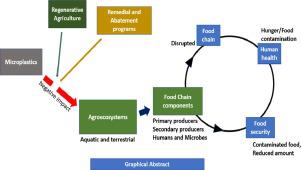Resources, Conservation and Recycling ( IF 11.2 ) Pub Date : 2021-10-14 , DOI: 10.1016/j.resconrec.2021.105961 Emmanuel Sunday Okeke , Charles Obinwanne Okoye , Edidiong Okokon Atakpa , Richard Ekeng Ita , Raphael Nyaruaba , Chiamaka Linda Mgbechidinma , Otobong Donald Akan

|
This work reviews microplastic's impact on agroecosystem components and possible effects on the food chain. Microplastics are sized < 5 µm, made up of diverse chemical constituents, and come from several sources. The agroecosystems reportedly receive an estimated 1.15 to 2.41 million tonnes of plastic wastes annually. Microplastic factors like increasing anthropogenic activities, tiny sizes, ubiquity, sheer volume, and composite chemicals greatly influence the environment. Their impact could be directly on the food substances or indirectly on the ecosystems that support the primary producers of the food chain: alters plant's growth and developments, blocks organisms’ digestive/roots system, attachment for multiplying organisms, vectors of toxic compounds, disrupts the activities of microbial decomposers and nutrient cycles, etc. Microplastic contamination of the agroecosystems reduce food yields, impact the food chain components negatively, food security, and human health. The adoption of regenerative agriculture is staging the cultivation of food substances away from contaminable systems while using sustainable sources of water and minerals. The consequences of increasing microplastic volume and attendant impacts make researchers evaluate alternative solutions for microplastic abatement: bio-based plastics and the adoption of clean remedial biotechnologies. These alternate solutions are expedient as the total elimination of plastic (microplastic) waste may not be fully feasible- considering their recalcitrance and non-biodegradability. Also, policymakers should promulgate laws that mitigate and replace single-use and non-biodegradable plastic materials with bio-based or biodegradable alternatives.
中文翻译:

农业生态系统中的微塑料——对生态系统功能和食物链的影响
这项工作回顾了微塑料对农业生态系统组成部分的影响以及对食物链的可能影响。微塑料的尺寸小于 5 µm,由多种化学成分组成,并且有多种来源。据报道,农业生态系统每年接收估计 1.15 至 241 万吨塑料废物。微塑料因素,如增加的人为活动、微小的尺寸、无处不在、庞大的体积和复合化学物质,极大地影响了环境。它们的影响可能直接影响食物物质,也可能间接影响支持食物链初级生产者的生态系统:改变植物的生长和发育、阻碍生物的消化/根系、繁殖生物的附着、有毒化合物的载体、破坏微生物分解者的活动和养分循环等。农业生态系统的微塑料污染会降低粮食产量,对食物链组成部分、粮食安全和人类健康产生负面影响。再生农业的采用是在使用可持续的水源和矿物质的同时,逐步种植食物物质,使其远离受污染的系统。微塑料体积增加的后果和随之而来的影响使研究人员评估了微塑料减排的替代解决方案:生物基塑料和采用清洁的补救生物技术。这些替代解决方案是权宜之计,因为完全消除塑料(微塑料)废物可能并不完全可行——考虑到它们的顽固性和不可生物降解性。还,











































 京公网安备 11010802027423号
京公网安备 11010802027423号